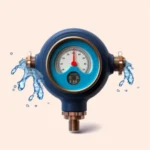WATER PRESSURE EXPLAINED
Many homeowners, at some point, confront the challenges of low water pressure, be it due to sluggish taps or protracted cycles of washing machines. The team at Maintracts encounters such issues routinely, emphasizing the importance of understanding water pressure. In this guide, we delve into the intricacies of water pressure and water flow, examining the standard pressure expectations, common issues, measurement methods, and the divergence between water pressure and flow.

What is Water Pressure?
Water pressure delineates the force applied to propel water through mains into the pipes of our residences, businesses, and communal spaces.
Standard Water Pressure in a House
In the UK, the vigor of water, or its pressure, is quantified in ‘bar’ or metres per head. Suppliers are mandated to deliver a minimum of one bar or 10 metres/head of mains water pressure, signifying sufficient force to elevate water to a height of 10m. This measurement is taken at the juncture where water transitions from the supplier’s pipework at street level to your own.
Pressure discrepancies are not uncommon, influenced by geographical and structural variables. Older, elevated structures, particularly in London, often grapple with diminished pressure and water flow, with demand fluctuations also playing a pivotal role in pressure variations, especially during peak usage times.
Distinguishing Between Water Pressure and Water Flow
A prevailing misconception equates water pressure and flow, deeming them interrelated. However, these are disparate entities. Water pressure is a force measure, whereas water flow gauges volume, representing the quantity of water traversing through pipes or outlets, measured in litres per minute. Notably, while these entities are distinct, water flow rate can often reflect the overarching water pressure in your abode.
Importance of Monitoring Water Pressure at Home
Regularly assessing your home’s water pressure is pivotal for averting unwarranted water consumption and identifying potential plumbing anomalies, thus facilitating optimal household functionality. Abrupt alterations in water pressure can herald plumbing complications, such as leaks or blockages, or even exert excessive strain on fixtures and appliances, culminating in deterioration and leaks. Hence, addressing abrupt pressure changes promptly is paramount.
How to Assess Water Flow Rate?
To gauge your water flow rate – a proxy for water pressure – you necessitate a measuring jug and a stopwatch. This uncomplicated method involves filling a jug for six seconds and subsequently multiplying the accrued volume by 10 to ascertain the flow rate. A flow rate below 10 litres per minute suggests low water volume, necessitating interventions for enhancement.
Addressing Water Pressure Issues
Instances of suboptimal water flow rate due to improperly commissioned taps and valves are recurrent. Many contemporary taps and showers are designed for high-pressure water supplies, rendering them inefficient when linked to low-pressure supplies. Conversely, excessive water production from certain outlets can compromise flow rates from others, a scenario especially prevalent in properties with inherently limited water supplies.
If you have any issues with your water pressure, contact Topflow Services Ltd 07856780000






